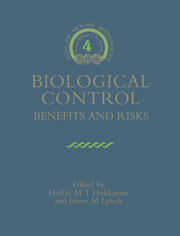Book contents
- Frontmatter
- Contents
- List of Contributors
- Series Preface
- Preface: Overview of Benefits and Risks of Biological Control Introductions
- Part I Biological Invasions
- Part II Classical Biocontrol
- Part III Augmentative Biocontrol
- Part IV Use of Genetically Modified Organisms
- 19 Assessing the Potential Benefits and Risks of Introducing Natural and Genetically Manipulated Bacteria for the Control of Soil-borne Root Diseases
- 20 Serodiagnostic Methods for Risk Assessment of Pseudomonas cepacia as a Biocontrol Agent
- 21 Benefits and Risks of Using Genetically Engineered Baculoviruses as Insecticides
- 22 Mathematical Modelling of Gene Exchange in Soil
- 23 Pest Resistance to Bacillus thuringiensis: Ecological Crop Assessment for Bt Gene Incorporation and Strategies of Management
- 24 An International Perspective for the Release of Genetically Engineered Organisms for Biological Control
- Part V Economics and Registration
- Index
23 - Pest Resistance to Bacillus thuringiensis: Ecological Crop Assessment for Bt Gene Incorporation and Strategies of Management
Published online by Cambridge University Press: 07 May 2010
- Frontmatter
- Contents
- List of Contributors
- Series Preface
- Preface: Overview of Benefits and Risks of Biological Control Introductions
- Part I Biological Invasions
- Part II Classical Biocontrol
- Part III Augmentative Biocontrol
- Part IV Use of Genetically Modified Organisms
- 19 Assessing the Potential Benefits and Risks of Introducing Natural and Genetically Manipulated Bacteria for the Control of Soil-borne Root Diseases
- 20 Serodiagnostic Methods for Risk Assessment of Pseudomonas cepacia as a Biocontrol Agent
- 21 Benefits and Risks of Using Genetically Engineered Baculoviruses as Insecticides
- 22 Mathematical Modelling of Gene Exchange in Soil
- 23 Pest Resistance to Bacillus thuringiensis: Ecological Crop Assessment for Bt Gene Incorporation and Strategies of Management
- 24 An International Perspective for the Release of Genetically Engineered Organisms for Biological Control
- Part V Economics and Registration
- Index
Summary
Introduction
While integrated pest management research has sought to reduce the use of pesticides in agriculture over the past 30 years, current public and political pressure has increased dramatically the urgency of the search for alternatives. Few are immediately available, and this places particular reliance on some key biological control agents. One such agent is Bacillus thuringiensis Berliner (Bt), which is the most widely used biopesticide. Sales have doubled in the past 4 years and are conservatively forecast to rise by 20% per year in the future, leading to a market of US$ 300-500 million by 1995 or 5–10% of global insecticide sales by the year 2000 (Anonymous, 1991–6). In addition to the expanding use of Bt as a microbial pesticide, the Bt genes responsible for its efficacy as a pesticide have become a primary source of insect toxins for those who seek to produce transgenic crops resistant to insects. It was reported by Watkinson (1992) that at least 50 plant species have been transformed with Bt genes and the list is being constantly added to. This brings closer the prospect of Bt toxins becoming widely and persistently distributed in the environment.
There is a growing criticism and concern about this genetic approach to pest control (Harris, 1991; van Emden, 1991; Anderson, 1992). Insects have exceeded most projections of their ability to develop resistance to pest control methods applied against them, and this now includes Bt.
- Type
- Chapter
- Information
- Biological ControlBenefits and Risks, pp. 236 - 252Publisher: Cambridge University PressPrint publication year: 1995
- 9
- Cited by



